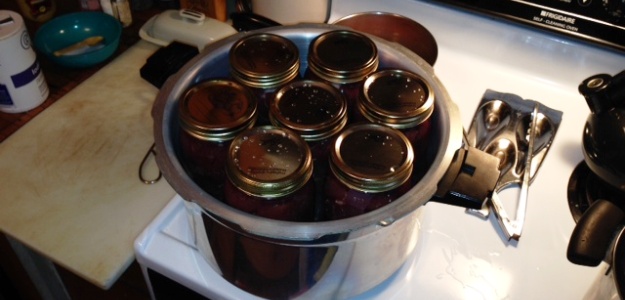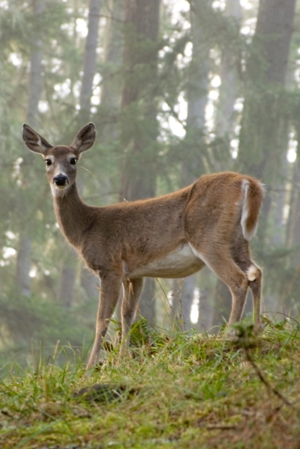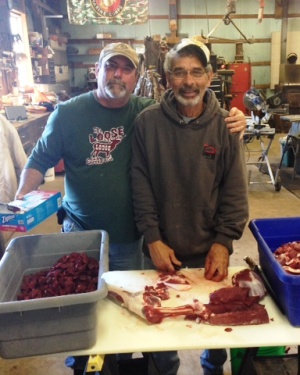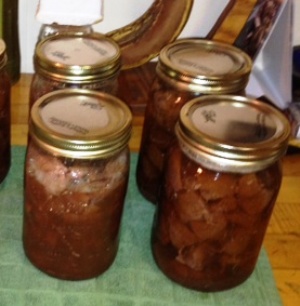By Cory Dukehart | Mossy Oak ProStaff

I grew up spending a lot of summer weekends and holidays on a farm owned by a great family friend named Rodney Lane. Rod (as he is called by his friends) is a self-sufficient man. He lives in the very small mountain town of Cranesville, WV. In this area of the country, you have to be self-sufficient to survive. It’s not because they live in conditions like the 1800s but because grocery, hardware and convenience stores are an hour’s drive. It certainly helps to be prepared for the worst before it happens in Cranesville.
Last winter, the small town got over 22 feet of snow and was without power for weeks at a time on two separate occasions. Rod is the type of guy who can rebuild a motor and then start building a house from the ground up. He is a jack of all trades. I have learned a lot from him over the years and I look forward to what I will learn from him in the future.
West Virginia recently started an early, doe-harvest-only rifle season the last weekend in October. The last two years this season has fallen on my father’s birthday and it has become one of our favorite times to get into the woods together. My father, me, and my coon dog “Boone” hopped in the truck on Wednesday evening and headed west to my parents’ house. Rod and my father built this house on the land that my parents bought from him. We literally are the guests that wouldn’t leave!
We didn’t arrive until late in the evening, grabbed a quick bite and hit the sack as Thursday was the opener for the short season. My dad and I hunted blinds behind our house overlooking a cut hay field. We both had high expectations to fill our freezer on this morning because the deer had not been hunted very hard by bow hunters yet in this area, and we always see lots of movement across this field. However, nothing moved. We hunted all morning and neither of us saw a deer. After discussing our plan with Rod the three of us loaded up the ATVs and headed up the mountain to sit until dark.
 It was October, 24th 2013 and it was about 28 degrees with almost 2 inches of snow on the ground. Perfect conditions for a deer hunt. That evening my dad was able to get a nice doe off of the mountain and as I was waiting for him at the ATV, a doe came running towards me. I pulled my rifle, but my scope was fogged and I wasn’t exactly sure of my dad’s location in relation to where I was standing at the time, so I let it pass on by. A missed opportunity for sure, but it wasn’t worth it considering the possible consequences. I helped him load up his deer and we headed back down the mountain.
It was October, 24th 2013 and it was about 28 degrees with almost 2 inches of snow on the ground. Perfect conditions for a deer hunt. That evening my dad was able to get a nice doe off of the mountain and as I was waiting for him at the ATV, a doe came running towards me. I pulled my rifle, but my scope was fogged and I wasn’t exactly sure of my dad’s location in relation to where I was standing at the time, so I let it pass on by. A missed opportunity for sure, but it wasn’t worth it considering the possible consequences. I helped him load up his deer and we headed back down the mountain.
The next morning I hunted the hay field again as I had so much luck hunting there in years past. I just knew it couldn’t do me wrong two mornings in a row. However, I was mistaken again. Rod and I decided we would head back to the top of the mountain again that evening. He had a portable climber stand in the woods that he was using, and I walked an old logging road until I found a nice rock formation that provided me with a surprisingly comfortable bench to sit on. It was still cold and still spitting snow and freezing rain. I was overlooking a valley and could see a nice distance down to the bottom. The snow fall that had accumulated over the last two days made for a nice back drop that should easily allow me to spot a doe slipping through the trees. I assumed I would be able to hear her coming a mile away considering the crunching noise I made on the snow/ice covered ground coming in.
About an hour before dark I caught movement from the corner of my eye on the right side. Sure enough, about 50 yards away was a nice doe easing her way past me from the bottom. I couldn’t believe I never heard her. I grabbed my gun and had to awkwardly turn to my right to make the shot. By now she had slipped behind a large deadfall of trees and I couldn’t see her from my sitting position. I was concerned that when she cleared the deadfall, I would only be offered a shot towards her rear that I was not comfortable taking. In a completely unconventional fashion with a deer this close to me, I stood up and turned towards her. Of course in doing so she completely had me made, but I could now see her and had a perfect shot. I took a quick aim and sent the round as she was looking right at me through the crosshairs. She fell where she stood and a moment of relief came over me as I thought I was about to blow this opportunity as well. While I was tending to her I heard another shot off in the distance. A few minutes later Rod confirmed over the radio he had also gotten his doe.
 The next morning, with all of us now having our tags filled, we slept in a bit and waited for the sun to rise. Our hunting was done, but the real work was just getting started. Rod worked for years as a professional butcher and watching him dice up a deer would amaze any redneck. My dad and I worked on getting the hides off of the deer while Rod sharpened up some blades for the work that was about to be done. We got the three deer skinned and quartered and watched Rod do the rest. He cut the roasts, steaks, and loin. And then he started filling two large plastic tubs with small cubed cuts of meat. One side was completely stripped of sinew skin and the other with the fattier pieces. The fattier pieces will end up going to the grinder to make burger or sausage. But we decided we would use the lean pieces to make canned venison. I was very excited to learn this process as I had never tried it.
The next morning, with all of us now having our tags filled, we slept in a bit and waited for the sun to rise. Our hunting was done, but the real work was just getting started. Rod worked for years as a professional butcher and watching him dice up a deer would amaze any redneck. My dad and I worked on getting the hides off of the deer while Rod sharpened up some blades for the work that was about to be done. We got the three deer skinned and quartered and watched Rod do the rest. He cut the roasts, steaks, and loin. And then he started filling two large plastic tubs with small cubed cuts of meat. One side was completely stripped of sinew skin and the other with the fattier pieces. The fattier pieces will end up going to the grinder to make burger or sausage. But we decided we would use the lean pieces to make canned venison. I was very excited to learn this process as I had never tried it.
Just as we were about to start the canning process our friend Bob pulled up to show us his daily catch from the trout river. Once Bob learned of what we were about to take on, he jumped right in and stayed the rest of the day to help us work on the project. I think it was because he knew we would give him a few quarts for lending a helping hand and for being our buddy! After hearing an explanation of the process we dove right into the task at hand. Rod’s pressure cooker could hold 7 one-quart jars. We loaded each jar with lean cut cubed venison and 1 teaspoon of salt. Do not add any water to your jars as the meat will produce its own water. Just pack them tight and leave about an inch or so at the top of each jar. Once this is completed you can tighten your lids and rings on your jars. Each jar got strategically placed in the pressure cooker which was filled with 3 quarts of water.
Canning meat is not like canning vegetables or jams. You do not need to have them in a water bath. Three quarts of water is all that is needed to create the pressure. Once the jars were placed in the cooker, we sealed it up and waited for steam. It’s important to let the steam release from the cooker for 10 minutes to remove any air from the canner. Once that happens you can put your pressure gauge on and set it to your desired pressure. All pressure cookers will come with an instruction booklet that will include recommended cooking times for different canning procedures. For the venison we set the pressure for 10 pounds. The key is to not start your timer until the pressure in your can reaches the desired level. Once that happens we set the timer for 1 hour and 15 minutes. The pressure gauge will release steam every so often to keep the pressure at 10 pounds. The trick is to keep the heat at a level that the pressure release is going off about 4 times a minute. Any more than that and you are cooking too hot, and any less than that and you are cooking too cool. It’s certainly not a “set it and forget it” process, but the end results are worth the work.
 Once the time is up we removed our pressure gauge and allowed the remainder of the steam to vent. Carefully opening the lid, we used the jar lifters to pull each jar out of the can and set it on a towel to cool. As the jars cool the lids will pull down and seal themselves making a popping sound. Once this happens these jars are persevered for at least the next two years. The meat inside them is fully cooked and can be opened and eaten straight from the jar if the situation called for it. Or these delicious little cuts can be added to soups or stews with only needing to be heated up.
Once the time is up we removed our pressure gauge and allowed the remainder of the steam to vent. Carefully opening the lid, we used the jar lifters to pull each jar out of the can and set it on a towel to cool. As the jars cool the lids will pull down and seal themselves making a popping sound. Once this happens these jars are persevered for at least the next two years. The meat inside them is fully cooked and can be opened and eaten straight from the jar if the situation called for it. Or these delicious little cuts can be added to soups or stews with only needing to be heated up.
We canned a total of 21 jars of venison and since we could only cook 7 jars at a time, this took us hours to complete. We sat in Rods farm house kitchen while each batch cooked and told stories and talked for hours. It was one of those days I know I will think back on and remember for years to come. Getting in the outdoors is what the trip was about, but I won’t remember the specific details of this doe hunt forever. However, the time spent with my dad, Rod and our friend Bob canning venison will always be a memory I will look back on and smile.

Need wild game meat for a recipe you've been wanting to try? Check out GameKeeper Butchery. GameKeeper Butchery is dedicated to procuring the finest assortment and highest quality of specialty meats from the United States and around the world. Our commitment is to deliver the safest, freshest and most wholesome products.




























